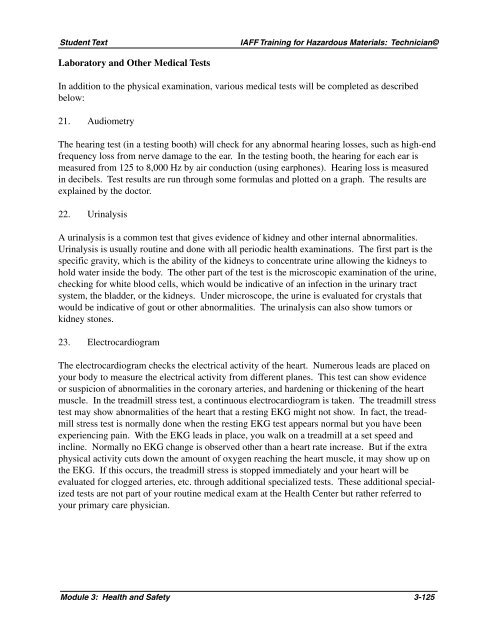Module 3: Health and Safety - IAFF
Module 3: Health and Safety - IAFF
Module 3: Health and Safety - IAFF
You also want an ePaper? Increase the reach of your titles
YUMPU automatically turns print PDFs into web optimized ePapers that Google loves.
Student Text <strong>IAFF</strong> Training for Hazardous Materials: Technician©<br />
Laboratory <strong>and</strong> Other Medical Tests<br />
In addition to the physical examination, various medical tests will be completed as described<br />
below:<br />
21. Audiometry<br />
The hearing test (in a testing booth) will check for any abnormal hearing losses, such as high-end<br />
frequency loss from nerve damage to the ear. In the testing booth, the hearing for each ear is<br />
measured from 125 to 8,000 Hz by air conduction (using earphones). Hearing loss is measured<br />
in decibels. Test results are run through some formulas <strong>and</strong> plotted on a graph. The results are<br />
explained by the doctor.<br />
22. Urinalysis<br />
A urinalysis is a common test that gives evidence of kidney <strong>and</strong> other internal abnormalities.<br />
Urinalysis is usually routine <strong>and</strong> done with all periodic health examinations. The first part is the<br />
specific gravity, which is the ability of the kidneys to concentrate urine allowing the kidneys to<br />
hold water inside the body. The other part of the test is the microscopic examination of the urine,<br />
checking for white blood cells, which would be indicative of an infection in the urinary tract<br />
system, the bladder, or the kidneys. Under microscope, the urine is evaluated for crystals that<br />
would be indicative of gout or other abnormalities. The urinalysis can also show tumors or<br />
kidney stones.<br />
23. Electrocardiogram<br />
The electrocardiogram checks the electrical activity of the heart. Numerous leads are placed on<br />
your body to measure the electrical activity from different planes. This test can show evidence<br />
or suspicion of abnormalities in the coronary arteries, <strong>and</strong> hardening or thickening of the heart<br />
muscle. In the treadmill stress test, a continuous electrocardiogram is taken. The treadmill stress<br />
test may show abnormalities of the heart that a resting EKG might not show. In fact, the treadmill<br />
stress test is normally done when the resting EKG test appears normal but you have been<br />
experiencing pain. With the EKG leads in place, you walk on a treadmill at a set speed <strong>and</strong><br />
incline. Normally no EKG change is observed other than a heart rate increase. But if the extra<br />
physical activity cuts down the amount of oxygen reaching the heart muscle, it may show up on<br />
the EKG. If this occurs, the treadmill stress is stopped immediately <strong>and</strong> your heart will be<br />
evaluated for clogged arteries, etc. through additional specialized tests. These additional specialized<br />
tests are not part of your routine medical exam at the <strong>Health</strong> Center but rather referred to<br />
your primary care physician.<br />
<strong>Module</strong> 3: <strong>Health</strong> <strong>and</strong> <strong>Safety</strong> 3-125
















